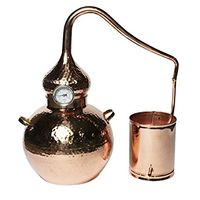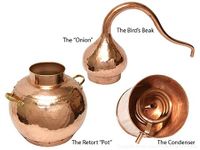Alembic Still: Difference between revisions
Jump to navigation
Jump to search
Uncle Jesse (talk | contribs) (Editing a poorly worded page) |
Uncle Jesse (talk | contribs) No edit summary |
||
| (One intermediate revision by the same user not shown) | |||
| Line 4: | Line 4: | ||
The word alembic comes from the Arabic الإنبيق (al-anbīḳ); from Greek ἄμβιξ (ambix), meaning cup or beaker. The alembic [[still]] consists of two vessels connected by a tube. The Alembic is one of the oldest and simplest [[Pot stills|pot stills]]. Still in use today for | The word alembic comes from the Arabic الإنبيق (al-anbīḳ); from Greek ἄμβιξ (ambix), meaning cup or beaker. The alembic [[still]] consists of two vessels connected by a tube. The Alembic is one of the oldest and simplest [[Pot stills|pot stills]]. Still in use today for whiskeys, [[rum|rums]] and [[fruit]] based [[spirit|spirits]]. Alembic stills maintain the most flavor from the original materials and are not used for [[neutral spirit|neutral spirits]] such as [[vodka]] as they cannot achieve the purity and high [[ABV|alcohol levels]] as a [[reflux still]]. | ||
When [[Distillation|distillation]] was brought from the Arab world to Europe, the name "Alembic" was brought with it. | When [[Distillation|distillation]] was brought from the Arab world to Europe, the name "Alembic" was brought with it. | ||
Latest revision as of 22:24, 11 December 2022
The word alembic comes from the Arabic الإنبيق (al-anbīḳ); from Greek ἄμβιξ (ambix), meaning cup or beaker. The alembic still consists of two vessels connected by a tube. The Alembic is one of the oldest and simplest pot stills. Still in use today for whiskeys, rums and fruit based spirits. Alembic stills maintain the most flavor from the original materials and are not used for neutral spirits such as vodka as they cannot achieve the purity and high alcohol levels as a reflux still.
When distillation was brought from the Arab world to Europe, the name "Alembic" was brought with it.


